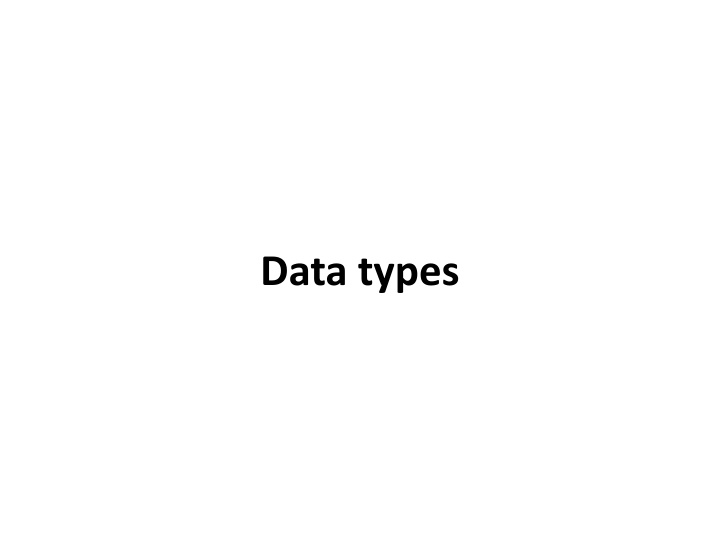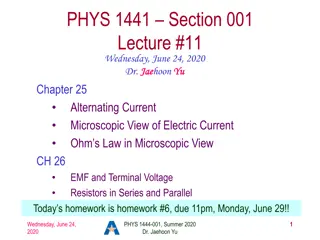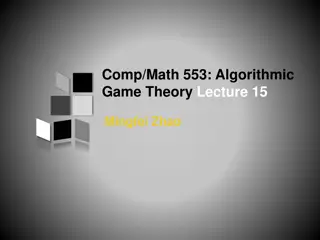
Basic Data Types and Integer Types in Programming
Dive into the world of basic data types (int, float, double, char, void) and integer types (short, long, signed, unsigned) in programming. Learn about their sizes, ranges, and usage in storing different kinds of values. Explore the relationships between character types and integer types, along with modifiers like unsigned. Enhance your knowledge of primary data types essential for programming.
Uploaded on | 1 Views
Download Presentation

Please find below an Image/Link to download the presentation.
The content on the website is provided AS IS for your information and personal use only. It may not be sold, licensed, or shared on other websites without obtaining consent from the author. If you encounter any issues during the download, it is possible that the publisher has removed the file from their server.
You are allowed to download the files provided on this website for personal or commercial use, subject to the condition that they are used lawfully. All files are the property of their respective owners.
The content on the website is provided AS IS for your information and personal use only. It may not be sold, licensed, or shared on other websites without obtaining consent from the author.
E N D
Presentation Transcript
Primary (built-in or Basic)Data types CHARACTER INTEGER SIGNED TYPE INT SHORT INT LONG INT UNSIGNED TYPE UNSIGNED INT UNSIGNED SHORT INT UNSIGNED LONG INT SIGNED CHARACTER UNSIGNED CHARACTER VOID FLOATING POINT TYPE FLOATING POINT TYPE FLOAT DOUBLE LONG DOUBLE VOID 4
Data types Basic data types: int, float, double, char, and void. int: can be used to store integer numbers (values with no decimal places). float: can be used for storing floating-point numbers (values containing decimal places). double: the same as type float, and roughly twice the size of float. char: can be used to store a single character, such as the letter a, the digit character 6, or a semicolon. void: is used to denote nothing or empty. 5
Integer Types The basic integer type is int The size of an int depends on the machine and on PCs it is normally 16 or 32 or 64 bits. modifiers (type specifiers) short: typically uses less bits long: typically uses more bits Signed: both negative and positive numbers Unsigned: only positive numbers 6
SIZE AND RANGE OF VALUES FOR A 16-BIT MACHINE (INTEGER TYPE) Type Size (bits) Range short int or signed short int 8 -128 to 127 short unsigned int 8 0 to 255 int or signed int 16 -32,768 to 32,767 Integer unsigned int 16 0 to 65,535 long int or signed long int -2,147,483,648 to 2,147,483,647 32 Long unsigned long int 32 0 to 4,294,967,295 7
The character type char A char variable can be used to store a single character. A character constant is formed by enclosing the character within a pair of single quotation marks. Valid examples: 'a . Character zero ( 0 ) is not the same as the number (integer constant) 0. The character constant \n the newline character is a valid character constant. It is called as an escape character. There are other escape sequences like, \t for tab, \v for vertical tab, \n for new line etc. 8
Character Types Character type char isrelated to the integer type. Modifiers(type specifiers) unsigned and signed can be used char signed char unsigned char 1 byte (-128 to 127) 1 byte (-128 to 127) 1 byte (0 to 255) ASCII (American Standard Code for Information Interchange ) is the dominant encoding scheme for characters. Examples ' ' encoded as 32 'A' encoded as 65 .'Z' encoded as 90 'a' encoded as 97 . 0 encoded as 48 .. 9 encoded as 57 '+' encoded as 43 'z' encoded as 122 9
Assigning values to char char letter; /* declare variable letter of type char */ letter = A'; /* OK */ letter = A; /* NO! Compiler thinks A is a variable */ letter = A"; /* NO! Compiler thinks A" is a string */ letter = 65; /* ok because characters are internally stored as numeric values (ASCII code) */ 10
Floating-Point Types Floating-point types represent real numbers Integer part Fractional part The number 108.1517 breaks down into the following parts 108 - integer part 1517 - fractional part Floating-point constants can also be expressed in scientific notation. The value 1.7e4 represents the value 1.7 104. The value before the letter e is known as the mantissa, whereas the value that follows e is called the exponent. There are three floating-point type specifiers float double long double 11
SIZE AND RANGE OF VALUES FOR 16-BIT MACHINE (FLOATING POINT TYPE) Type Size 32 bits 4 bytes Single Precision Float 64 bits 8 bytes Double Precision double Long Double Precision 80 bits 10 bytes long double 12
void 2 uses of void are To specify the return type of a function when it is not returning any value. To indicate an empty argument list to a function. 13
Summary of Memory Used Data Types Memory Size Range char 1 byte 128 to 127 signed char 1 byte 128 to 127 unsigned char 1 byte 0 to 255 short 2 byte 32,768 to 32,767 signed short 2 byte 32,768 to 32,767 unsigned short 2 byte 0 to 65,535 int 2 byte 32,768 to 32,767 signed int 2 byte 32,768 to 32,767 unsigned int 2 byte 0 to 65,535 14
Summary of Memory Used Data Types Memory Size Range short int 2 byte 32,768 to 32,767 signed short int 2 byte 32,768 to 32,767 unsigned int short 2 byte 0 to 65,535 long int 4 byte -2,147,483,648 2,147,483,647 to signed long int 4 byte -2,147,483,648 2,147,483,647 to unsigned long int 4 byte 0 to 4,294,967,295 float 4 byte double 8 byte long double 10 byte 15
Important You can always check the size of a variable using the sizeof sizeof() () operator. #include <stdio.h> int main() { short a; long b; long long c; long double d; printf("size of short = %d bytes\n", sizeof(a)); printf("size of long = %d bytes\n", sizeof(b)); printf("size of long long = %d bytes\n", sizeof(c)); printf("size of long double= %d bytes\n", sizeof(d)); return 0; } 16
Best Practices for Programming Best Practices for Programming Naming Variables According to Standards Prefix Data Type Example i f d l c ai af ad Array of double al Array of long integers ac Array of characters int and unsigned int float double long and unsigned long signed char and unsigned char Array of integers Array of float iTotalMarks fAverageMarks dSalary lFactorial cChoice aiStudentId afQuantity adAmount alSample acEmpName 17
Example: Using data types #include <stdio.h> int main () { int integerVar = 100; float floatingVar = 331.79; double doubleVar = 144368.4411; char charVar = 'W'; printf( %d\n , integerVar); printf( %f\n ,floatingVar); printf( %lf\n ,doubleVar); printf( %c\n ,charVar); return 0; } 18






















